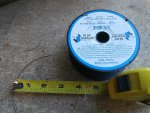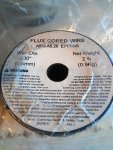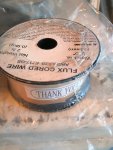Gary Fowler
Well-known member
- Messages
- 717
- Good Post Points
- 202
Welding rods are like diesel, stored correctly they last forever. The first thing I got after my welding machine was a Phoenix Dry Rod oven. It will hold 350# of rods if full and has 6 dividers in it to keep the sizes separated. It is only for low hydrogen rods. I keep the thermostat set at 300F all the time.
Cellulose coated rods like 6010 just need to be kept dry, DO NOT heat them. They actually need about 50% or more moisture content in order to run properly. If they get too dry, the flux will finger nail on you (burn off to one side). As long as the wire is rust free, welding rods will work fine. Same with MIG, TIG and FCAW wire.
So: how long do welding rods/wire last? When properly stored, forever.
If I had all the rods that I have thrown away during my 40 year construction career as QC manager, I could supply every welder on TBN with a lifetime supply. I routinely checked gang boxes for improperly stored rods and if I found low hydrogen (7018 mostly) in a gang box they went in the trash. Even overnight, in the gulf coast weather the wire under the flux would rust. Welders were notorious for just sticking his 10# rod oven in the gang box and not taking out the rods and putting them back in the storage oven. Since all the welders used rods from the rod over, structural and pressure piping welders, I couldn't take a chance on them being contaminated and used on pressure vessel or pressure piping welds. 6010 rods generally were ok left in a gang box as long as they dont get wet. Repeated wetting or prolonged storage in open atmosphere would leave a white coating on the flux which is a good indication the the wire underneath may have a slight rust coating. Any rusty wire is useless due to forming porosity when welded.
Cellulose coated rods like 6010 just need to be kept dry, DO NOT heat them. They actually need about 50% or more moisture content in order to run properly. If they get too dry, the flux will finger nail on you (burn off to one side). As long as the wire is rust free, welding rods will work fine. Same with MIG, TIG and FCAW wire.
So: how long do welding rods/wire last? When properly stored, forever.
If I had all the rods that I have thrown away during my 40 year construction career as QC manager, I could supply every welder on TBN with a lifetime supply. I routinely checked gang boxes for improperly stored rods and if I found low hydrogen (7018 mostly) in a gang box they went in the trash. Even overnight, in the gulf coast weather the wire under the flux would rust. Welders were notorious for just sticking his 10# rod oven in the gang box and not taking out the rods and putting them back in the storage oven. Since all the welders used rods from the rod over, structural and pressure piping welders, I couldn't take a chance on them being contaminated and used on pressure vessel or pressure piping welds. 6010 rods generally were ok left in a gang box as long as they dont get wet. Repeated wetting or prolonged storage in open atmosphere would leave a white coating on the flux which is a good indication the the wire underneath may have a slight rust coating. Any rusty wire is useless due to forming porosity when welded.





